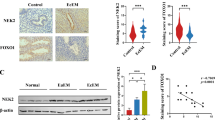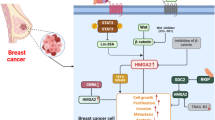Abstract
Recurrent spontaneous abortion (RSA) is a common health problem that affects 1–5% of women in reproductive age. Plenty of studies have indicated that microRNAs (miRNAs) are involved in the occurrence of miscarriage. MiR-93 has a wide range of functions in mammalian tissues and plays an important role in many diseases especially for cancers. However, it remains unknown whether miR-93 is associated with human RSA. In this report, clinical samples revealed that miR-93 expression was significantly elevated in the villi tissues of RSA patients. Upregulation of miR-93 inhibited human trophoblast cells HTR-8/SVneo cell proliferation, migration, and invasiveness, but promoted cell apoptosis in vitro. Conversely, the downregulation of miR-93 reversed these effects. Bcl-2 like protein 2 (BCL2L2), a potential target gene of miR-93, was inversely correlated with miR-93 expression in the villi of clinical samples. Furthermore, the luciferase reporter system demonstrated that miR-93 directly downregulated the expression of BCL2L2 by binding a specific sequence of its 3′-untranslated region (3′UTR). Collectively, these data strongly suggest that miR-93 regulates trophoblast cell proliferation, migration, invasive, and apoptosis by targeting BCL2L2 expression and is involved in the pathogenesis of RSA.





Similar content being viewed by others
References
Krieg SA, Fan X, Hong Y, et al. Global alteration in gene expression profiles of deciduas from women with idiopathic recurrent pregnancy loss. Molecular human reproduction. 2012;18(9):442–50.
Baek KH, Lee EJ, Kim YS. Recurrent pregnancy loss: the key potential mechanisms. Trends Mol Med. 2007;13(7):310–7.
Rai R, Rega L. Recurrent miscarriage. Lancet. 2006;368(9535):601–11.
Nybo Andersen AM, Wohlfahrt J, Christens P, et al. Maternal age and fetal loss: population based register linkage study. Bmj. 2002;320(7251):1708–12.
Lamont K, Scott NW, Jones GT, Bhattacharya S. Risk of recurrent stillbirth: systematic review and meta-analysis. Bmj. 2015;350:h3080.
Garrido-Gimenez C, Alijotas-Reig J. Recurrent miscarriage: causes, evaluation and management. Postgraduate medical journal. 2015;91(1073):151–62.
Avagliano L, Garò C, Marconi AM. Placental amino acids transport in intrauterine growth restriction. Journal of pregnancy. 2012;2012:972562.
Mendell JT, Olson EN. MicroRNAs in stress signaling and human disease. Cell. 2012;148:1172–87.
Bartel DP. MicroRNAs: target recognition and regulatory functions. Cell. 2009;136(2):215–33.
Filipowicz W, Bhattacharyya SN, Sonenberg N. Mechanisms of post-transcriptional regulation by microRNAs: are the answers in sight? Nat Rev Genet. 2008;9(2):102–14.
Gangaraju VK, Lin H. MicroRNAs: key regulators of stem cells. Nat Rev Mol Cell Biol. 2009;10(2):116–25.
Pan Q, Niu H, Cheng L, et al. Invasion of trophoblast cell lines is inhibited by miR-93 via MMP-2. Placenta. 2017;53:48–53.
Santamaria X, Taylor H. MicroRNA and gynecological reproductive diseases. Fertility and sterility. 2014;101(6):1545–51.
Wang X, Li B, Wang J, et al. Evidence that miR-133a causes recurrent spontaneous abortion by reducing HLA-G expression. Reproductive biomedicine onlin. 2012;e 25(4):415–24.
Dong F, Zhang Y, Xia F, et al. Genome-wide miRNA profiling of villus and decidua of recurrent spontaneous abortion patients. Reproduction. 2014;148(1):33–41.
Wang Y, Li F, Wang S. MicroRNA-93 is overexpressed and induces apoptosis in glaucoma trabecular meshwork cells. Mol Med Rep. 2016;14(6):5746–50.
Yan LJ, Fan XW, Yang HT, et al. MiR-93 inhibition ameliorates OGD/R induced cardiomyocyte apoptosis by targeting Nrf2. Eur Rev Med Pharmacol Sci. 2017;21(23):5456–61.
Qian Q, Sun W, Zhu W, Liu Y, Ge A, Ma Y, et al. The role of microRNA-93 regulating angiopoietin2 in the formation of malignant pleural effusion. Cancer Med. 2017;6(5):1036–48.
Liang L, Zhao L, Zan Y, et al. MiR-93-5p enhances growth and angiogenesis capacity of HUVECs by down-regulating EPLIN. Oncotarget. 2017;8(63):107033–43.
Choudhary GS, Al-Harbi S, Mazumder S, et al. MCL-1 and BCL-xL-dependent resistance to the BCL-2 inhibitor ABT-199 can be overcome by preventing PI3K/AKT/mTOR activation in lymphoid malignancies. Cell Death Dis. 2015;6:e1593.
Gibson L, Holmgreen SP, Huang DC, Bernard O, Copeland NG, Jenkins NA, et al. bcl-w, a novel member of the bcl-2 family, promotes cell survival. Oncogene. 1996;13(4):665–75.
Oda E, Ohki R, Murasawa H, et al. Noxa, a BH3-only member of the Bcl-2 family and candidate mediator of p53-induced apoptosis. Science. 2000;288(5468):1053–8.
Funding
This work was supported by grants from The National Key Research and Development Program of China (2016YFC1000307), the National Natural Science Foundation of China (No. 81771590), and CAMS Innovation Fund for Medical Sciences (CIFMS) (2018-I2M-1-004).
Author information
Authors and Affiliations
Corresponding author
Electronic supplementary material
ESM 1
(PDF 200 kb)
Rights and permissions
About this article
Cite this article
Liu, HN., Tang, XM., Wang, XQ. et al. MiR-93 Inhibits Trophoblast Cell Proliferation and Promotes Cell Apoptosis by Targeting BCL2L2 in Recurrent Spontaneous Abortion. Reprod. Sci. 27, 152–162 (2020). https://doi.org/10.1007/s43032-019-00003-w
Received:
Accepted:
Published:
Issue Date:
DOI: https://doi.org/10.1007/s43032-019-00003-w




